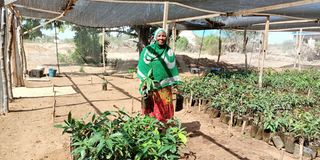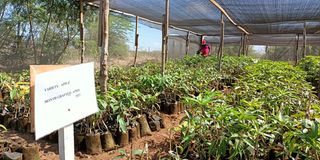Premium
Tana River woman earns tidy income from grafting fruit trees

Amina Mumbo Bakari at work in a fruits trees nursery bed in Hola, Tana River County where she does the grafting.
The mango has been a major cash crop in Tana River County for decades.
At least 20,000 households depend on the fruit for their livelihoods, including paying school fees for their children.
But mango production in Tana River has witnessed a decline in quantity and quality in recent years, from the usual 40,000 tonnes down to 30,000 tonnes now.
The original trees are no longer bearing fruits as they used to because of old age, leaving farmers in distress and with few options.
Enter Amina Mumbo Bakari, who is shaping fruit farming for the better through her grafting skills.
Not only does she graft mango seedlings for a variety that takes a short period to yield, but she also grafts orange, lemon and cashew nut seedlings
Her skills were honed at the National Irrigation Authority, where she and other farmers underwent training on grafting processes for a variety of fruits and trees.
“I learned how to graft oranges, apples and many other fruits, but I was more interested in mangoes, lemons, and oranges since they are the main cash crops in arid and semi-arid areas,” she says.
Inspired by the dwindling mango production, she embarked on grafting fruit varieties on order and imparting grafting skills to members of women’s groups.
Whereas the original mango tree takes five to seven years to start producing fruits, the grafted one takes only one and a half years, as do oranges and lemons.
Unlike the original tree, whose fruits have become prone to pests, affecting quality, a grafted mango tree is resistant to pests and for Tana farmers, a guarantee of better returns.
“Getting the original as the rootstock is not a task. However, the scion has to be sourced out of the region, and it’s expensive to transport,” she notes.
Her work begins at 6am, when she leaves the house for the nursery bed where, alongside a friend, they begin to select the root stalks and scions mature for grafting.

Some of the grafted Apple mangoes tree seedlings at the nursery bed in Hola,Tana River County.
The selection is meticulous and takes two hours, lest she picks immature rootstocks that will compromise the final product.
“I do close to 200 trees a day, and in all those, I may end up with one or two failing to take shape. We don’t throw them away but admit them back for nurturing and then re-graft them later,” she says.
She spends her whole day on the job, attending to clients in need of training for a fee and serving clients who need seedlings.
She sells a tree seedling for between Sh500-Sh600 depending on the height and the variety required.
She makes up to Sh50,000 in a good month and Sh25,000 when the season is low.
Most of her clients are farmers from Lamu and Kilifi counties, environmentalists from the region and local farmers.
“Most of the local farmers don’t understand where the market is headed in terms of mango production. They still want to hold on to traditional practices whose productivity is in quick decline,” she says.
She owns a tree nursery that serves as a classroom and where she nurtures seedlings for grafted oranges and mangoes. She is also trying to graft hardwood trees.
Ms Bakari also plays a key role in grafting, training and nurturing seedlings at Hola NIA tree nursery, where she manages more than 1,500 tree seedlings.
Ms Bakari is very resourceful and plays a pivotal role in inspiring diversity in the horticultural sector in Tana River, says Hola NIA Manager James Kirimi.
“The current trees will not satisfy the fruit-processing plant. We are seeing a scenario where farmers from Garissa who have started planting the grafted variety will be key suppliers to the plant,” he says.
The Integrated Fruit Processing Plant in Boji started operations recently. It has the capacity to crush eight tonnes of mangoes a day to produce pulp for juice making.
Mr Kirimi urges women in the county to start grafting fruit trees and use them to generate income as it is one of the most sought-after skills in the world.





